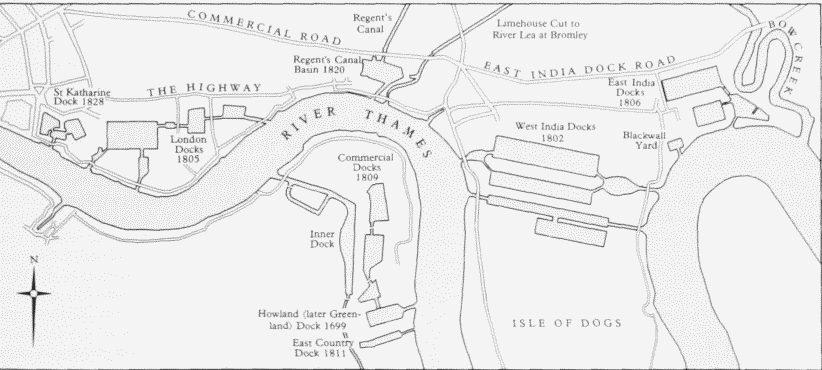Survey of London: Volumes 43 and 44, Poplar, Blackwall and Isle of Dogs. Originally published by London County Council, London, 1994.
This free content was digitised by double rekeying. All rights reserved.
'The West India Docks: Introduction', in Survey of London: Volumes 43 and 44, Poplar, Blackwall and Isle of Dogs, (London, 1994) pp. 247-248. British History Online https://www.british-history.ac.uk/survey-london/vols43-4/pp247-248 [accessed 19 April 2024]
CHAPTER X - The West India Docks
The wet docks that were built along the Thames in the early nineteenth century for the loading and unloading of cargo were constructed in response to growing demands for the modernization of the Port of London. By the late eighteenth century the increase in London's trade, both overseas and coastal, was producing overcrowding in the river and delays in the discharging of cargoes. Those quays which were licensed by the Customs for the receipt of dutiable imports — the 'legal quays' and 'sufferance wharves' — were increasingly clogged and were unable to deal quickly and efficiently with the volume of goods being landed. Congestion was a particularly acute problem for vessels engaged in the West India trade, which were in the river for only a few months, from July to October. The merchant community's exasperation with the slowness of operations in the Port was exacerbated by the inadequate security arrangements. The delays in the bringing of cargoes off the river, the open quays and the West India merchants' scattered warehousing made it difficult to secure goods adequately. Losses from theft, not least to the Exchequer itself, were running at such a level that they were causing increasing, indeed almost hysterical, concern by the end of the eighteenth century. A solution to these problems was seen to be enclosed wet docks, with secure boundaries and ample quayside warehousing.

London's enclosed wet docks in 1838, wiht the dates of opening
The numbers of vessels engaged in overseas trade that used the port increased from 1,335 in 1705, to 1,682 in 1751, and to 3,663 in 1794, and the cargo tonnage rose even more sharply, from 234,639 tons in 1751 to 620,845 in 1794. The size of ships also increased in the eighteenth century: the number of London-based ships of over 200 tons rose from 205 in 1732 to 751 by 1792. Coastal trade was said to have almost doubled between 1750 and 1796, and was growing rapidly in the 1790s, from 9,287 vessels in 1792 to 11,964 in 1795 (fn. 1). Roughly two-thirds of coastal vessels were colliers, and the demand for coal rose as the city's population increased, from 675,000 to 900,000 inhabitants in the second half of the eighteenth century.
The problems in the Pool of London were at their worst when the ships arrived from the West Indies Some of the delays and difficulties were inherent in the system of loading and unloading. The larger ships discharged their cargoes into lighters that unloaded at the 'legal quays' and 'sufferance wharves', which had a very restricted frontage. The problems were increased by the reduced depth of water at the quays and in the channel, caused by the silt and sewage flowing out of the city's sewers and by the deposit of ballast from ships.
Similar problems had been experienced elsewhere and had been tackled by the construction, during the eighteenth century, of commercial wet docks at Bristol, Hull, and, most notably and extensively, at Liverpool. Henry Johnson's wet dock at Blackwall, completed in 1661, and converted to be the Brunswick Dock in 1790, and the Howland Dock at Rotherhithe, opened in 1699, provided precedents for enclosed wet docks on the Thames, although both were built for the refitting of ships rather than as cargo docks.
The increasing demand from the merchants for a system of commercial docks eventually received backing from the Corporation of London, which had overall responsibility for the river. It became aware that, unless improvements were made, London would lose trade to other British ports. This danger had increased with the outbreak of the war with France in 1793, for the vessels trading from the Atlantic ports ran less risk of capture by privateers than did those using the ports along the English Channel and North Sea coasts. The war also increased the congestion in the river, for the introduction of convoys for merchantmen meant that vessels arrived in groups, rather than singly. Other interests that had to be reconciled to a change in the operation of the Port included Trinity House, which was responsible for pilotage in the Thames, and the Customs, wharf owners and operators, warehouse keepers, watermen and lightermen.
Nevertheless, the obstacles were overcome, and by the time that the first London dock boom came to an end in 1815 the West India, East India and London Docks had been built on the north side of the Thames, and the Commercial and East Country Docks on the Surrey side. Such coherent large-scale improvements to London have seldom been attempted and rarely achieved. The dock-building of the early nineteenth century was the first major planned improvement of London's fabric since the post-Fire rebuilding. The other large docks built along the Thames during the nineteenth century were the St Katharine, Poplar, Royal Victoria, Millwall, Royal Albert and Tilbury Docks on the north side, with additions to the Surrey Docks on the south side. The West India, East India, Millwall and Poplar Docks were within Poplar (fig. 89).
